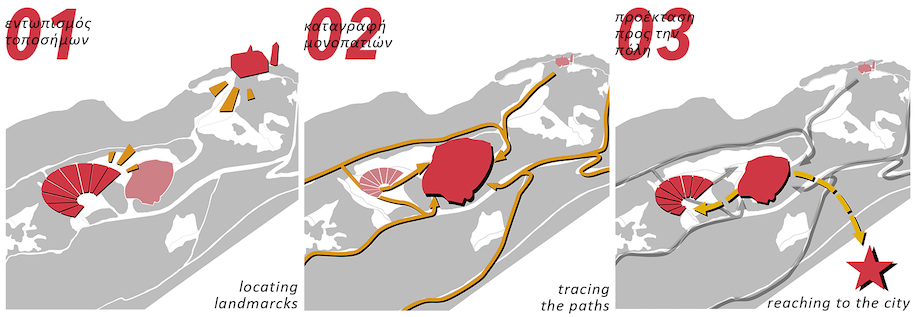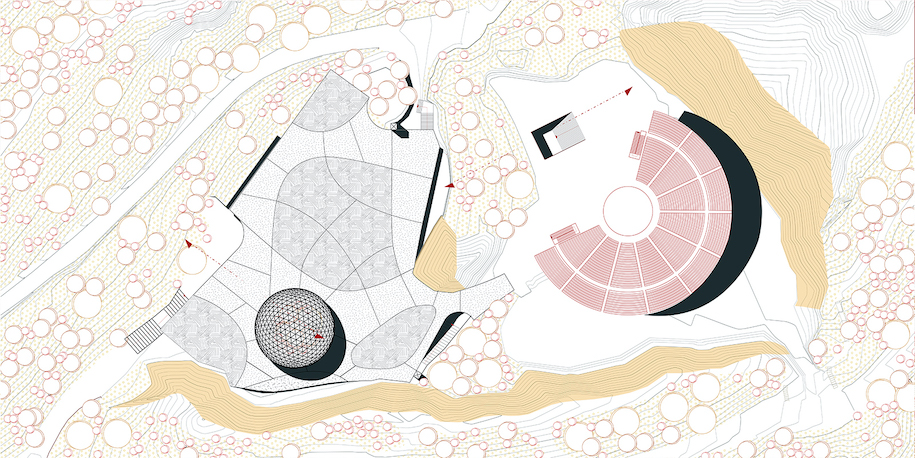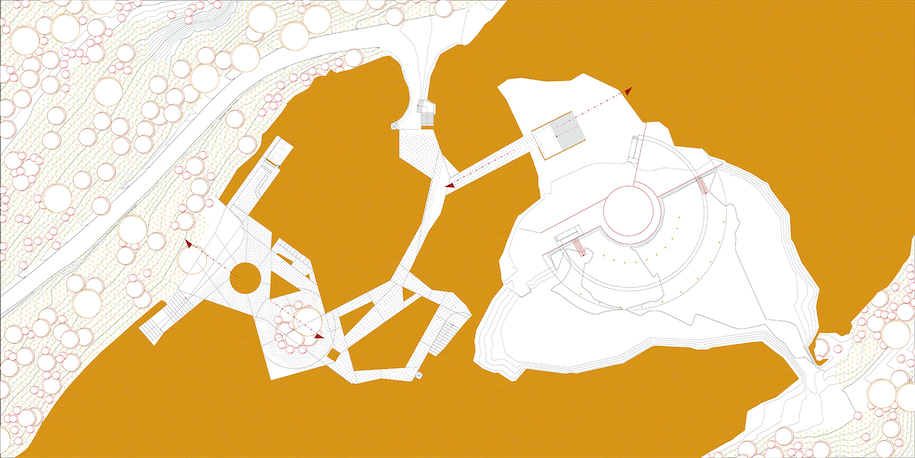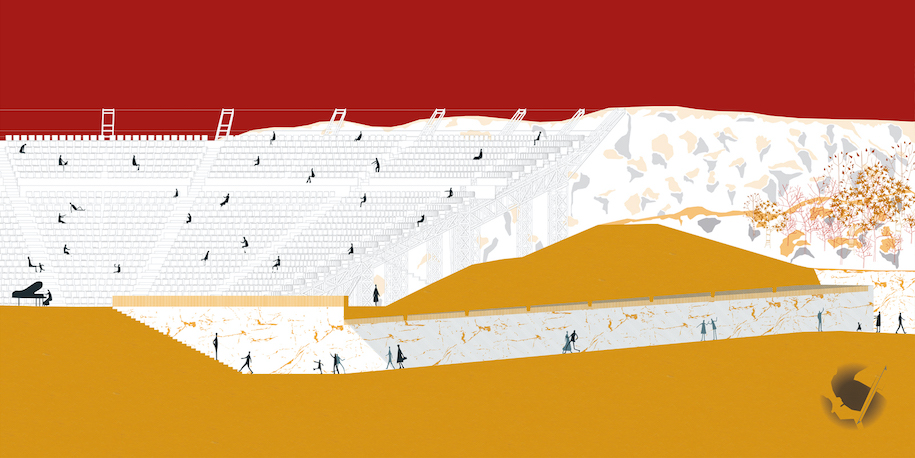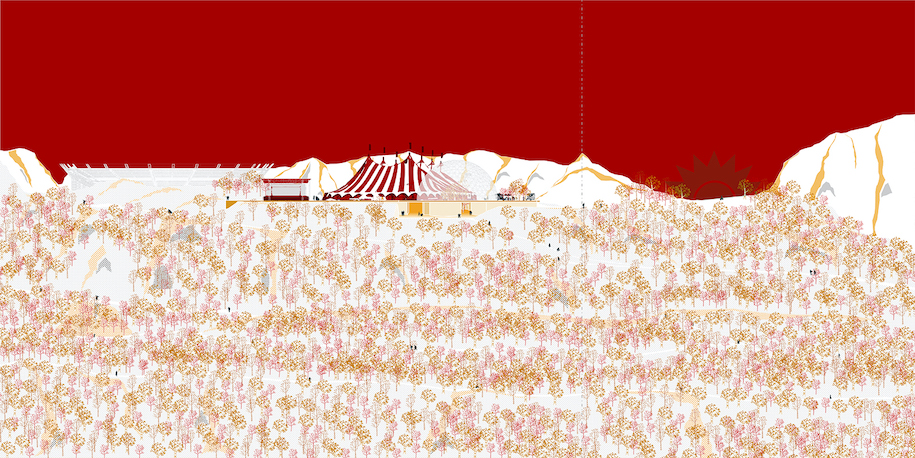For all the balconies, plateias, avenues, and roaring cars, over the nocturnal hubbub from packed stoas Athens has to offer, is it ultimately in its singular topographic morphology that reside the inner metaphorical lyricism, and the intense geographical poetry of the city?
-Text provided by the authors
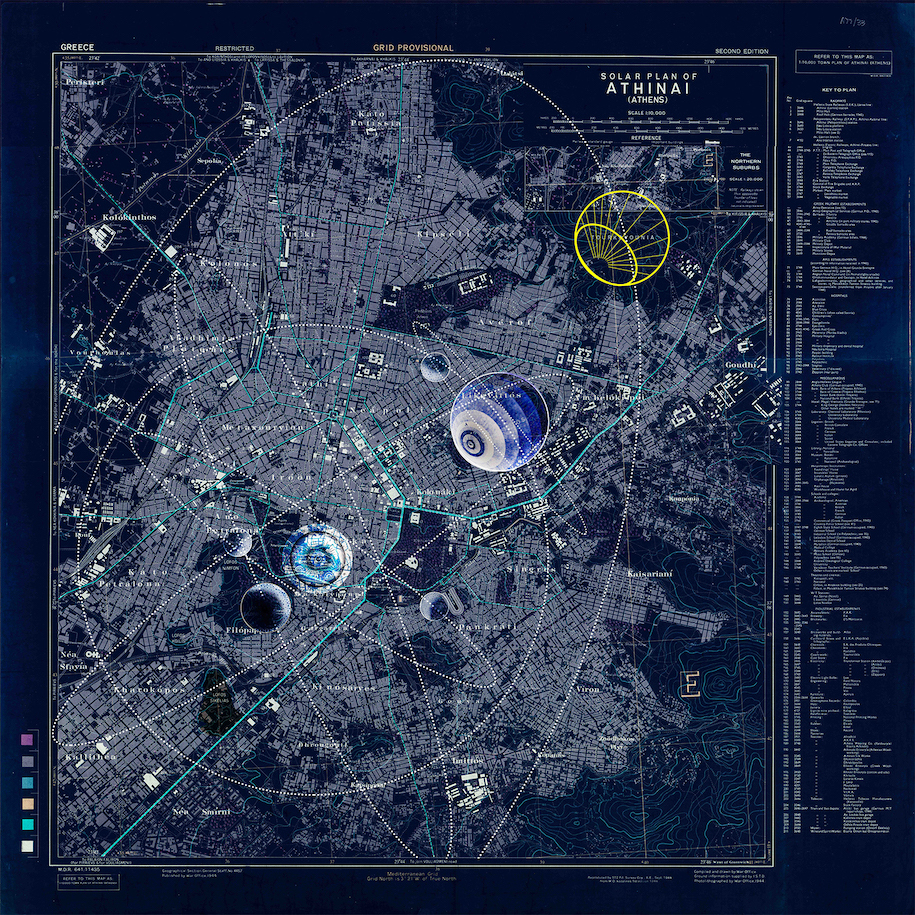
The dual revolution of Lycabettus
There lies the imagery of the capital, voluptuously described as a constellation of “hills and natural remains that float in the city fabric and around the Acropolis” [Athens By Hills, Point Supreme, 2010]. A constellation it is, we therefore comprehend greater-Athens as a galactic complex, a star system of hills with a strong gravitational core, a sun; the Acropolis. The hills are indeed centres of attraction, large unbuilt objects, polarizing the grid of the city. And superlative to all, the sun of the touristic colony casts the intensifying light of touristification; facing the Parthenon are the bright sides of the hills and their advantageous views enjoyed from gentrified neighbourhoods and their rich and temporary residents; segregated on the other side is a more topical and non-touristic part of the standing rocks.
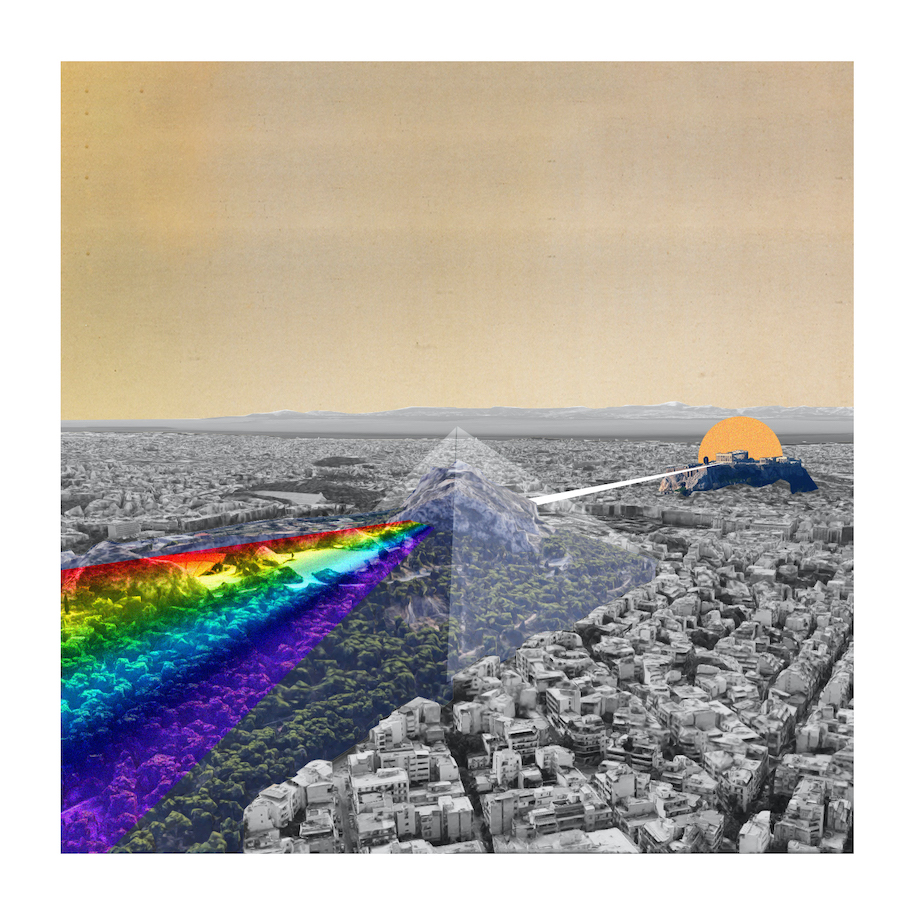
Lycabettus is the largest hill within central Athens, a contesting dipole with the Sacred Rock. Still, it is a vivid example of the dichotomy inherent to the Athenian hills. On the one hand, the path leading to Agios Georgios at the top of the hill is scoured by thousands of visitors, removing it from their locals’ realm of the city, making it a must-see landmark. On the other hand, the opposite side, the dark side of Lycabettus, and its parking lot overhanging the city, are left as a space in transition, an anti-hero to the touristic narrative for Athenians to foregather.
Historically a place of topical reference, the dark side embodies a tradition of corporal appropriation. More than anything, it is a complex that encompasses several layers of the symbols and temporalities associated with the Athenian identities. Born from the extraction of the stones that built the Athenian polykatoikias, the abandoned quarry was then rehabilitated into Zenetos’ theater for the resurrection of the ancient drama, in the 60s; then turned into a venue for the concerts of the youth; the parking lot of Lycabettus is ultimately and mainly a public space when no longer a car-park, used as a sandlot for drifting pimped rides and Athenians’ intimate meetings under the stars. Throughout its recent history, it has often been a kind of anti-monument, a significant location on the margins of mass culture.
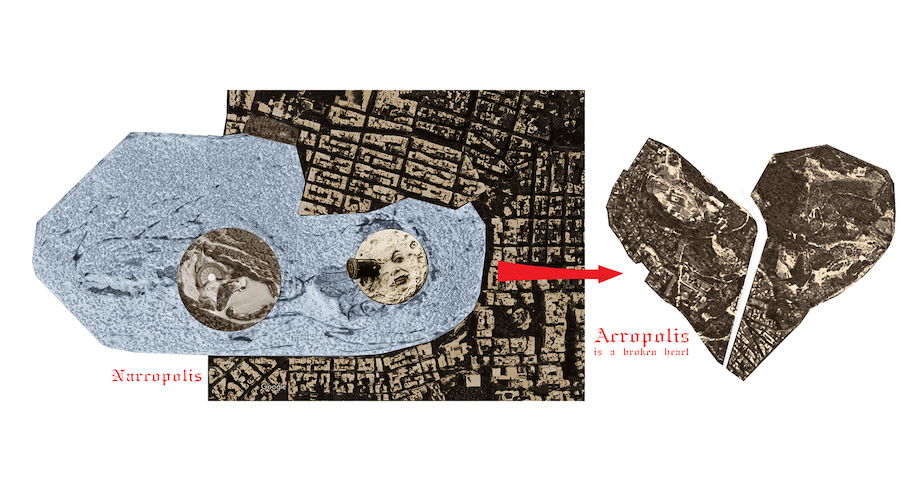
The platform
Contemplating the charged context of the sandlot, its traces of tire on the asphalt, the naked rocks around it, and the scaffold-like, unexploited theatre partially hiding; we saw a platform condensing all this life, its history written in rubber and ash, and decided to maintain it. We shaped it out of the existing tarmac, chiselling its borders, and digging a branching underground passage that forms the new entrance to Zenetos’ theatre. A big oculus was then carved to connect the underground with the platform, and a garden with trees was planted and a covered by a ventilating geodesic dome forming a greenhouse.
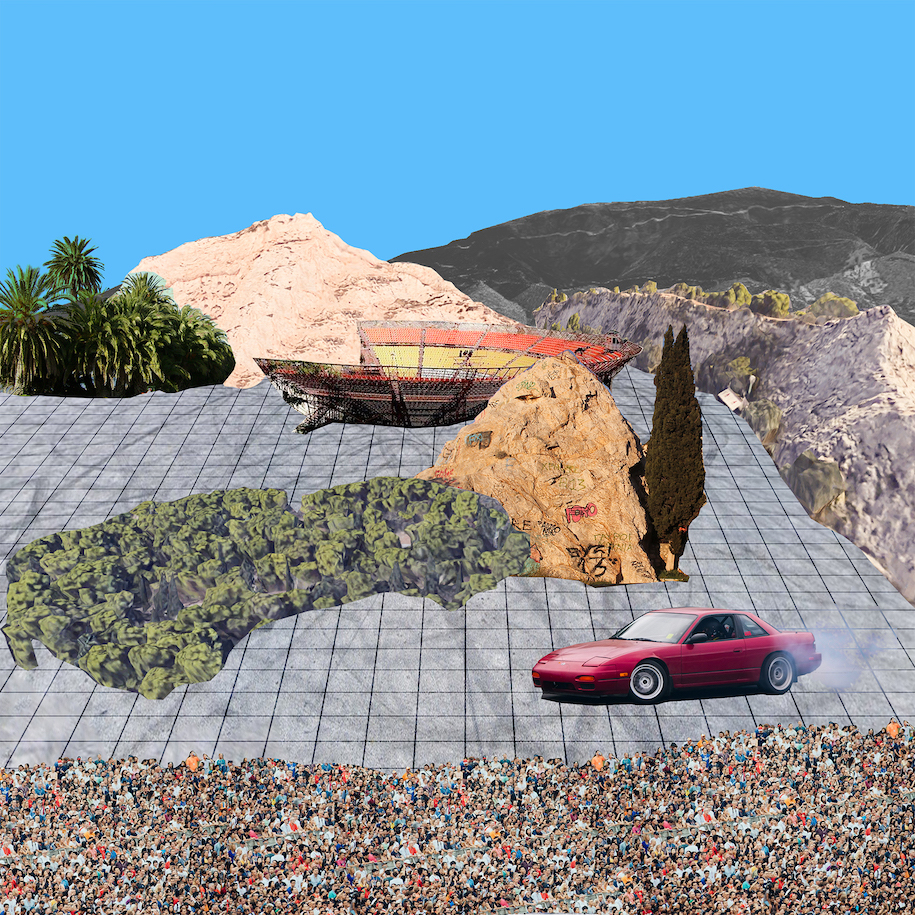
The underground reconnects the city with the theatre, by creating a new entrance in a solemn yet intimate gesture. The large cave-like space, formed by a path that connects the theatre, three staircases and two elevators leading to the platform, the garden under the dome and a balcony towards Athens, is inhabited by a small cafeteria/bar for the regulars, on the edge, framing a view of the rock of Agios Georgios.
The platform, a vast plateia, is explored through a map of potential futures. Destined to become a condenser for collective events like parties, gatherings, carnivals, basketball matches or the test flight for a pedal-powered aircraft.
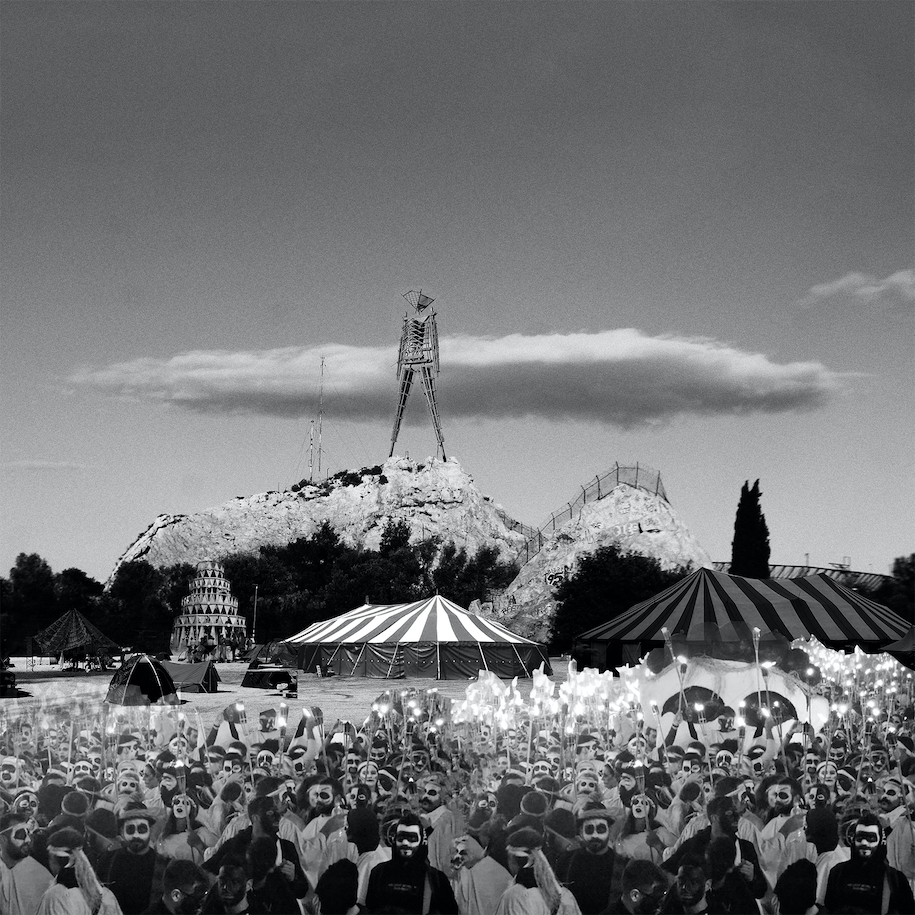
Anti-monument and collective identity
In the end, the dichotomy of Lycabettus is a way to open a study on the notion of patrimony and its contribution to collective identity. Is there a cultural immutable heritage of symbols, or is the culture a constantly evolving corpus of social conventions? Instead of arbitrating we adopt another posture; through the prism of intersectionality and inclusiveness, we view culture as the ever-growing and changing palimpsest of conventions and symbols we inherit and commonly use. Away from the myth of a universalist ideal but through the dissident nourished by togetherness in communal entities.
Therefore, the very goal was to avoid engraving new symbols in the stone, but rather to maintain a space where it would be possible to express those new and sometimes ephemeral parameters of a collective identity while juxtaposing them with the relics of the community. In a sense, this platform follows its own rules, evolves constantly, becomes a versatile space for collectivity: the anti-monument is a mental construction that exists within the collective memory, imagery and custom.
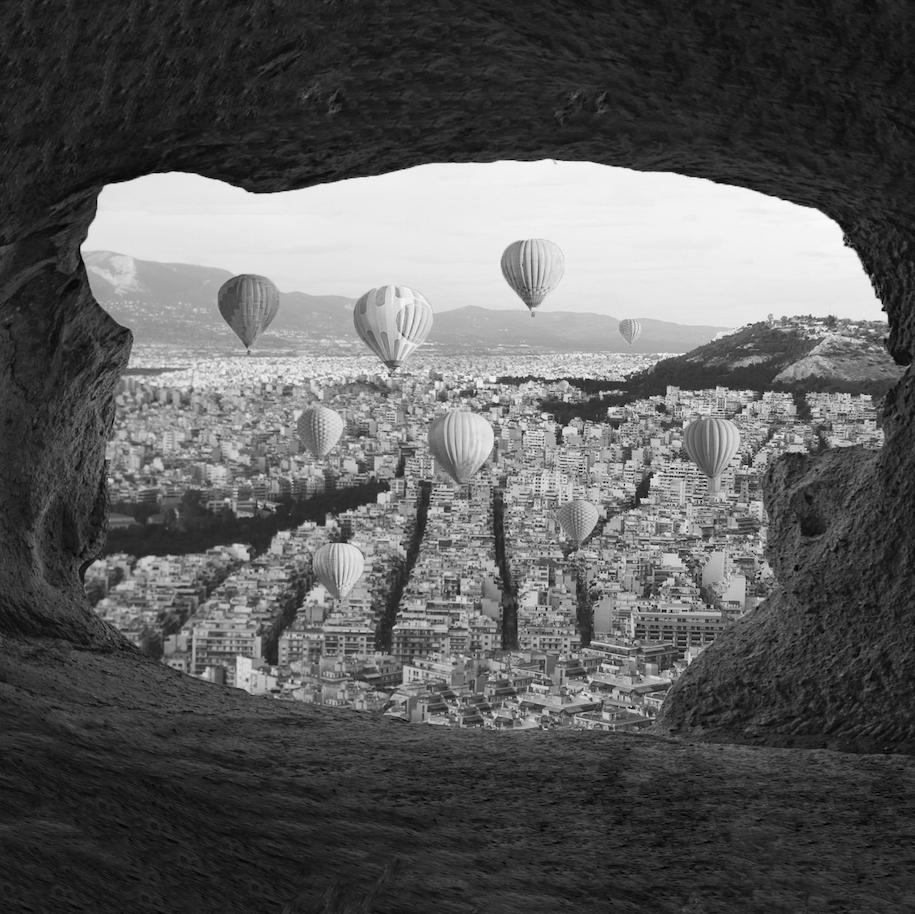
Facts & Credits
Project Title The far side: Meddling with the tourist narrative on the hill of Lycabettus
Students Manu Zaparta, Raji Aletcheredji
Supervisor Thanos Pagonis, Myrto Kiourti
Course Architectural design 8A: Outdoor public Architecture in physical and urban landscape
University School of Architecture, NTUA
Year 2020
Η διπλή περιστροφή του Λυκαβηττού
Από όλα τα μπαλκόνια, τις πλατείες, τις λεωφόρους και τα πολύβουα στενά, την ζάλη των αμαξιών και το σούσουρο πάνω πο τις νυχτερινές στοές της Αθήνας, είναι τελικά στην μοναδική τοπογραφία της που έγκειται ο εσωτερικός λυρισμός και η έντονη γεωγραφική ποιητικότητα της πόλης;
-Κείμενο από τους δημιουργούς
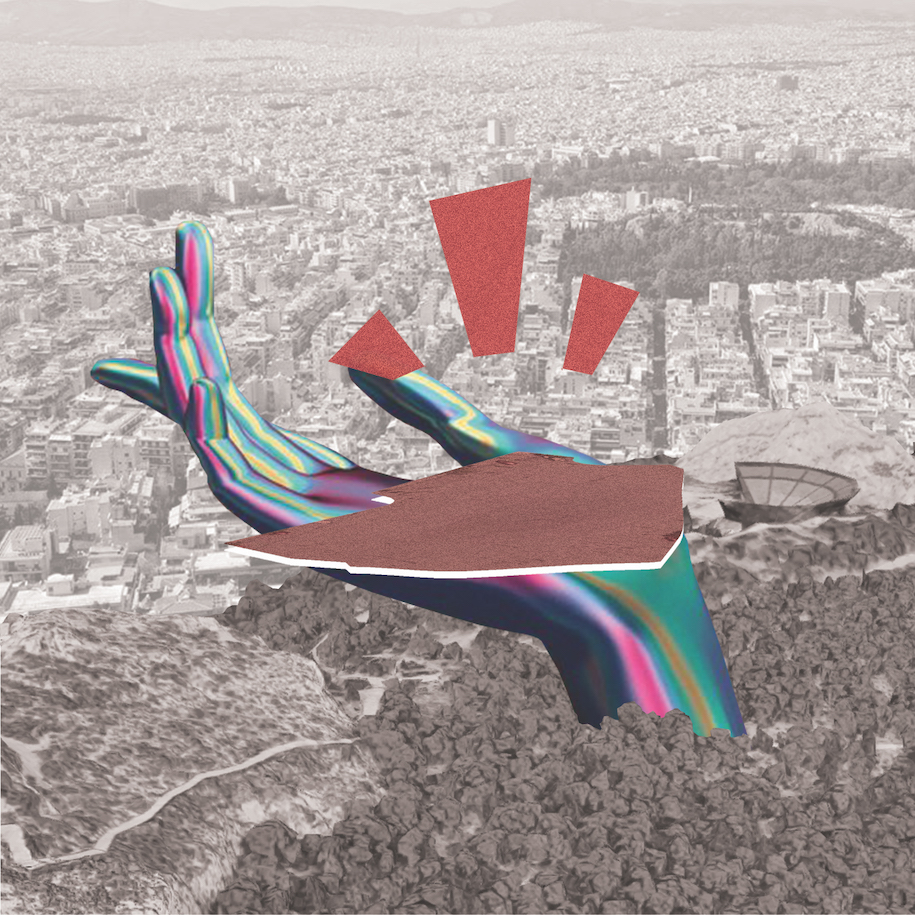
Υπάρχει ένα φαντασιακό της πρωτεύουσας, που πληθωρικά την περιγράφει ως ένα σύνολο από “λόφους και φυσικά κατάλοιπα που επιπλέουν στον αστικό ιστό και γύρω από την Ακρόπολη” [Athens By Hills, Point Supreme, 2010]. Αντιληφθήκαμε το λεκανοπέδιο ως ένα ηλιακό σύστημα του οποίου οι πλανήτες -οι λόφοι- στρέφονται γύρω από ένα κεντροβαρικό σημείο -ήλιο-, την Ακρόπολη. Οι λόφοι δημιουργούν κέντρα έλξης, ως μεγάλα αδόμητα αντικείμενα, γύρω από τα οποίους ο ιστός της πόλης σμιλεύεται. Και σημαντικότερος από όλους, ο ήλιος της τουριστικής αποικίας εκπέμπει την λάμψη της τουριστικοποίησης. Η φωτεινή πλευρά των λόφων βλέπει τον Παρθενώνα με τους πλούσιους ή προσωρινούς κάτοικους των εξευγενισμένων γειτονιών που τον απολαμβάνουν, ενώ η άλλη πλευρά χαρακτηρίζεται ως η πιο λόκαλ, και μη τουριστική.
Ο Λυκαβηττός, ο μεγαλύτερος λόφος της κεντρικής Αθήνας, δημιουργεί ένα ανταγωνιστικό δίπολο με τον Ιερό Βράχο, αποτελώντας κραυγαλέο παράδειγμα αυτού του διαχωρισμού. Από την μία, η πλευρά που κοιτάει την Ακρόπολη με το μονοπάτι και την εκκλησία του Αγίου Γεωργίου στην κορυφή, απήχθη από την σφαίρα της πόλης, καταπατημένη από γκρούπ τουριστών. Από την άλλη, η «σκοτεινή», πίσω πλευρά του Λυκαβηττού, με το πάρκινγκ που ατενίζει την πόλη, αφημένη ως χώρος σε μετάβαση, αντι-ήρωας στο τουριστικό αφήγημα.
Άχρονο σημείο αναφοράς για τους Αθηναίους, η πίσω αυτή πλευρά ενσαρκώνει μια παράδοση σωματικής οικειοποίησης. Ένα σύμπλοκο, που περιλαμβάνει πολλαπλά επίπεδα συμβολισμών και προσωρινοτήτων συσχετισμένων με την Αθηναϊκή ταυτότητα. Ο χώρος προέκυψε από την λατόμηση της πέτρας που έκτισε τα σπίτια της Αθήνας, ενώ στο κενό επενέβη με το θέατρο ο Ζενέτος. Όταν το θέατρο έπαψε να στεγάζει το αρχαίο δράμα, μετατράπηκε σε χώρο ταυτόσημο των νεανικών συναυλιών, της επικρατούσας μουσικής σκηνής. Η αλάνα μπροστά του -όταν δεν ήταν πάρκιν- είναι κατεξοχήν χώρος δημόσιος, μια άσφαλτος όπου οι κάγκουρες ντριφτάρουν και μερικά παγκάκια όπου παρέες ή ζευγαράκια απολαμβάνουν τον έναστρο ουρανό. Καθόλη την πρόσφατη ιστορία έχει υπάρξει κατά κάποιον τρόπο ένα αντί-μνημείο, ένας σημαίνων τόπος στα όρια της μαζικής κουλτούρας.
Η πλατφόρμα
Αναλογιζόμενοι τα επιφορτισμένα συγκείμενα της αλάνας, τα σημάδια από λάστιχα στην άσφαλτο, τον γυμνό βράχο πίσω της, το ρημάζον θέατρο-σκαλωσιά που μισοφαίνεται, είδαμε μια πλατφόρμα να συμπυκνώνει όλη αυτή τη ζωή και αποφασίσαμε να την διατηρήσουμε. Την σχηματίσαμε από την προϋπάρχουσα άσφαλτο, σμιλεύοντας τα όρια της και σκάβοντας ένα διακλαδούμενο υπόγειο πέρασμα που δημιοργεί τη νέα είσοδο στο θέατρο του Ζενέτου. Μια μεγάλη οπή λαξεύεται στο κέντρο για να ενώσει το επίγειο με το υπόγειο, και ένας κήπος με δέντρα φυτεύεται και καλύπτεται από έναν αεριζόμενο θόλο, ο οποίος δημιουργεί θερμοκήπιο.
Το υπόγειο, επανασυνδέει την πόλη με το θέατρο, δημιουργώντας μια νέα είσοδο με μια λιτή αλλά ευαίσθητη χειρονομία. Ο ημιυπαίθριος, σπηλαιώδης χώρος που δημιουργείται από το -σκαμμένο στον βράχο- πέρασμα που συνδέει το θέατρο, δύο πλατώματα με κλίμακες και ανελκυστήρες προς την πλατφόρμα και τον κήπο κάτω από τον θόλο, εκτονώνεται σε ένα μπαλκόνι προς την Αθήνα. Στην κόγχη, ένα μικρό καφέ/μπαρ, μετεξέλιξη μιας καντίνας, λόγω του σκαμμένου αποκτάει και κάδρο προς τον βράχο του Άγιου Γεώργιου.
Η πλατφόρμα, μια εκτενής πλατεία, διερευνάται μέσω ενός χάρτη δυνητικών προοπτικών. Προδιαγράφεται να γίνει ένας πυκνωτής συλλογικών εκδηλώσεων και δράσεων, από καρναβάλια και διονυσιακές δοξασίες, μέχρι συγκεντρώσεις, ανοιχτές προβολές, αθλητικούς αγώνες ή δοκιμαστικές πτήσεις πεταλοκίνητων αεροσκαφών.
Το αντι-μνημείο και η συλλογική ταυτότητα
Τελικά η διχοτόμηση του Λυκαβηττού ανοίγει μια συζήτηση πάνω στην ιδέα της κληρονομιάς και της συμβολής της στον σχηματισμό της συλλογικής ταυτότητας. Υπάρχει μια πολιτιστικά αμετάβλητη κληρονομιά συμβόλων, ή είναι η κουλτούρα ένα συνεχώς εξελισσόμενο σώμα κοινωνικών συμβάσεων; Αντί να μεσολαβούμε, υιοθετούμε μια άλλη στάση· μέσω της διαθεματικότητας και της συμμετοχικότητας, βλέπουμε την κουλτούρα ως ένα διαρκώς αναπτυσσόμενο και μεταλλασσόμενο παλίμψηστο συμβάσεων και συμβόλων που κληρονομούμε και ευρέως χρησιμοποιούμε. Μακριά από τον μύθο ενός οικουμενικού ιδεώδους, αλλά μέσω της ετερότητας που καλλιεργεί η συντροφικότητα των κοινών.
Στόχος, λοιπόν, δεν ήταν το να χαράξουμε νέα σύμβολα στους βράχους αλλά, αντιθέτως, να αφήσουμε τον χώρο ώστε να εκφραστούν αυτές οι νέες και πολλές φορές εφήμερες παράμετροι μιας συλλογικής ταυτότητας, ενώ θα αντιπαραβάλλονται με τα σύμβολα της κοινότητας. Κατά έναν τρόπο, η πλατφόρμα ακολουθεί τους δικούς της κανόνες, εξελίσσεται συνεχώς, γίνεται ένας πολυμορφικός χώρος και ένας πολυδιάστατος τόπος: το αντι-μνημείο είναι μια νοητική κατασκευή που υφίσταται στην διασταύρωση του έθιμου, της συλλογικής μνήμης και το συλλογικού ασυνείδητου.
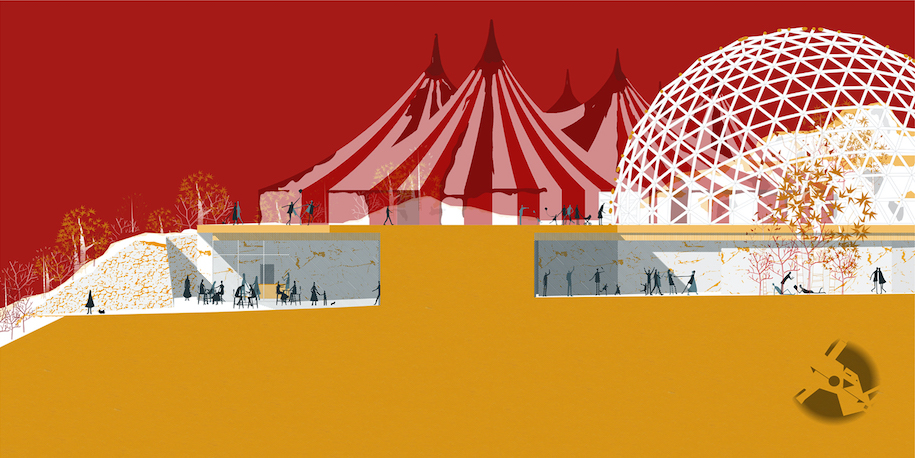
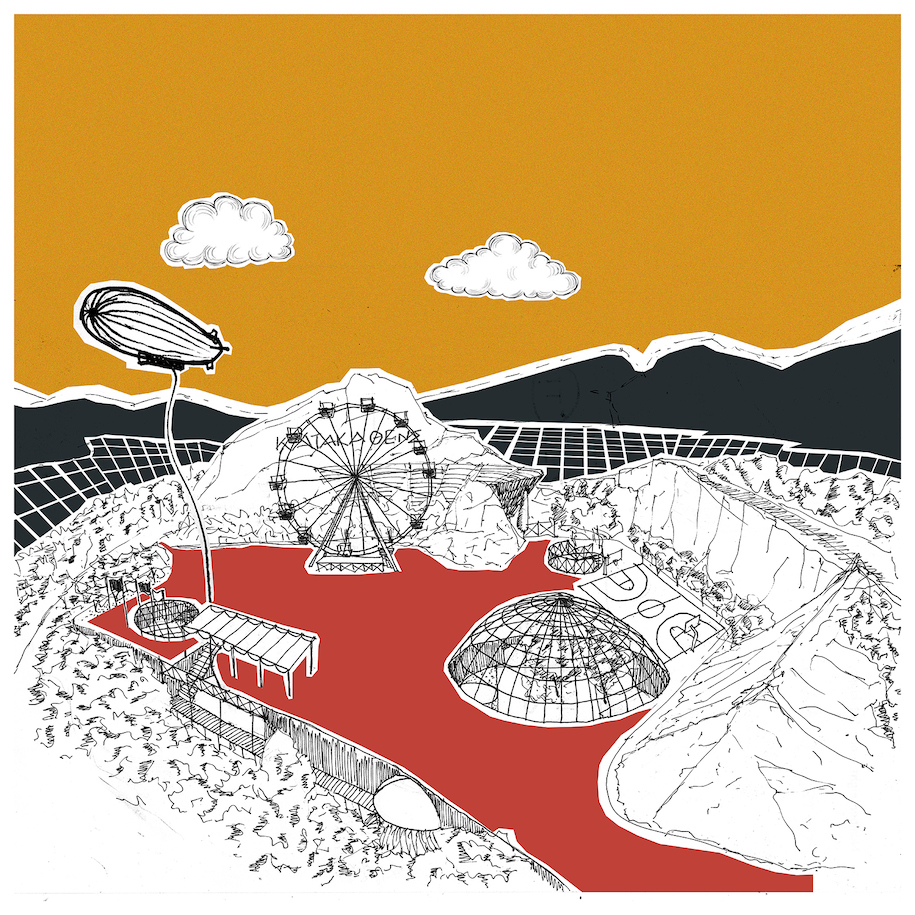
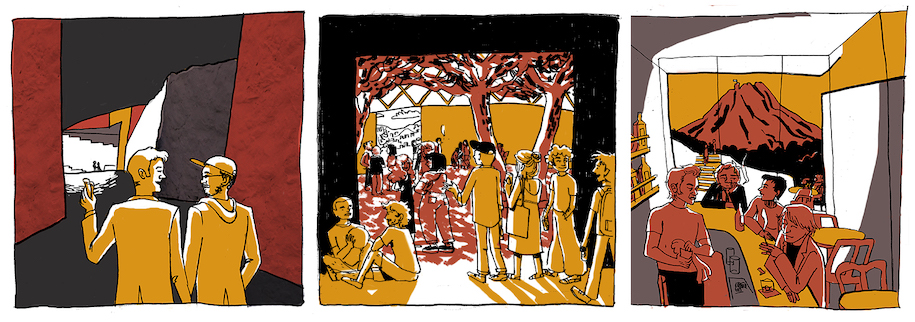
Στοιχεία εργασίας
Τίτλος Εργασίας Η διπλή περιστροφή του Λυκαβηττού
Σπουδαστές Manu Zaparta, Raji Aletcheredji
Επιβλέπων Θάνος Παγώνης, Μυρτώ Κιούρτη
Μάθημα Αρχιτεκτονικός σχεδιασμός 8Α: Αρχιτεκτονική υπαίθριων δημοσίων χωρών σε αστικό και φυσικό τοπίο
Σχολή Σχολή Αρχιτεκτόνων, ΕΜΠ
Έτος 2020
READ ALSO: Αφετηρία περιήγησης στο ιστορικό, πολιτιστικό και φυσικό τοπίο στην Αντίπαρο και το Δεσποτικό | από τη Χρυσή-Λήδα Σκορδίλη και τη Δανάη Τσέλου
